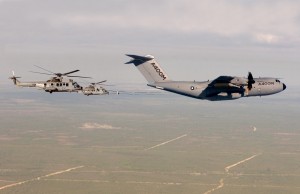5/24/12
by Robbin Laird
The visit to Spain and France to participate in the Airbus Military Trade Media Briefing provided an opportunity to look again at the evolution of the A330 multi-mission tanker and the A400M.
21st century air systems are designed differently from older military systems.
 This has been a constant theme for the Second Line of Defense team. Whether we are looking at the F-35, the 400M or the new A330 tanker, there is a core point – these are not simply platforms, there are parts of a FLEET approach or concept.
This has been a constant theme for the Second Line of Defense team. Whether we are looking at the F-35, the 400M or the new A330 tanker, there is a core point – these are not simply platforms, there are parts of a FLEET approach or concept.
Earlier, I wrote about what I see as the 3 “Ms” for the 21st century fleet.
In today’s world, the acquisition of aircraft in financially stringent environments favors multi-mission platforms. The U.S. and allied air forces are buying less aircraft and a smaller variety of aircraft. The expectation is that the aircraft purchased will do more than their core specialty.
There is an expectation that if I buy an airlifter it will do more than airlift. It will be able to refuel, it will be able to deliver in the air lethal and non-lethal weapons out of the back of the aircraft, it will be able to become a C2 aircraft if needed, etc…..
The second M is maintainability. We have had a special focus in our publications on what we call manufacturing for maintainability. New platforms are built with a significant amount of attention to how to enhance their ability to be maintained over time. When platforms were built thirty years ago, logistics support was an afterthought. Now it is a core element of determining successful outcomes to the manufacturing process…..
The final M is manufacturability. Briefing slides and simulations are not the same thing as a finished good of high quality and of high reliability. Here you need a trained workforce, good engineering practices and an ability to deliver a product of high quality and standards. It is challenging to build new systems and not every manufacturer is created equal.
https://sldinfo.com/defense-security-publications/
Getting a chance to see the multi-mission tanker and the A400M underscored how the two might work together. Indeed, in an interview published earlier on the website, we looked at how a task force concept might be shaped to leverage the two in providing a hub to an operational spoke of operations.
The preparation of the A400M for its refueling role underscored the inherent task force qualities of the aircraft as part of a FLEET.
With a refueable tanker, the tanker can be configured with crew rest areas and kept operational throughout the duration of an operation or mission sets. This larger tanker can fuel the A400M, which in turn can fuel elements of a sea-base operation or helos, UAVs, or whatever is needed to engage in close air support or insertion operations.
In effect, you are creating a refueling hub, which can support the wide range of air operations necessary in 21st century land and sea operations.
And with Libya and Bold Alligator 2012 underscoring the virtual integration of land and sea operations, a refueling hub is crucial to providing support for integrated air operations.

